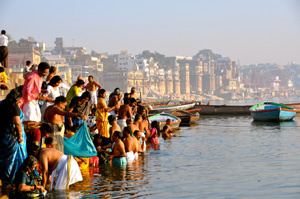By Amy Yu
Hong Kong, China

Amy Yu
|
You are standing on concrete Chowk Road, one of the main arteries bringing vehicles, autorickshaws, pedal rickshaws and animals into the city, which runs parallel to the west bank of the river. Like much of India, the sounds are deafening and the unsettled dirt and exhaust forms an almost tangible fog around you. The road sits a kilometer or two inland and the only way from here to the river is through a network of narrow alleyways called galis. Take a left, step into your first gali and only the animals can follow you.
The galis may be too narrow for most vehicles, but the chaos doesn’t cease. The small walls of buildings, temples and storefronts seem acoustically ideal to enhance the cacophony of sounds swirling around you. The cows groaning and mooing seem five times louder, and you can barely hear yourself think over the constant beeping of motorcyclists forcing their way through the six-foot wide walkway. Call to prayers from the mosques and the clanking and bells from the Hindu temples mix with the chanting of hundreds of holy men, baba, and beats from the tabla. From all sides, salesmen and touts call out chapatti chapatti? there, saree silk? here, chai?, samosa?, hotel? Betel nut? You are lost soaking this all in, but seconds to yourself here are rare as a group of bulled-up men announce their approach with a repetitive Hindu chant unrecognizable to you. They fly by in a flurry of colors, several of them carrying a bamboo stretcher with what looks like a body wrapped in shiny orange and crimson material, covered with garlands of white and vibrant purple, red flowers. A small train of chanting male followers run after them, watch out or they’ll bowl you over. You wonder who they are and where they are going. And is that a sitar you hear wafting out of the shutters above?

Henna-ed hands
|
No time to wonder…you must keep walking lest you irritate the crowd of people walking behind you, now that the procession has passed. Colors flurry in front of you like a kaleidoscope, silk sarees and scarves of literally the entire rainbow spectrum hang in every other store against the walls; they flutter in the wind and from the momentum of the bodies flying by, their gold threads and gem and mirror studs glittering in the early sunlight. Babies look back at you with heavily-lined eyes as their mothers dressed in these same colorful sarees carry them past you. Bindis and other marks and blessings bestowed on passerby faces confuse you as you attempt to distinguish between placement and colors and what they all may mean. Head full of hair dyed red, long white beards. Henna-ed hands point you through as you continuously ask “ghat? ghat?” in fear of walking in circles through this maze of alleys. You’ve let your mind wander too far and all of a sudden your kaleidoscope shatters, the crowd splitting ahead of you to let a large cow meander through. Watch those horns. You step into a storefront to regroup, but only for a second as the owner descends upon you with determination only rivaled by a senior in high school trying to score on prom night.
Jumping back out into the cobbled walkway, you curse yourself for landing in one of the many puddles connected by rivers of standing water, putrid and murky. The concoction of scents finally starts registering, fighting its way to your attention between all your other completely overloaded senses. Laying the foundation, smells of animal fecal matter dominate along with the undeniable odor of old and fresh urine. You then pick out the pungent scent of animals themselves, their damp hides and their musty breath. But like a fine perfume, there are sweet top notes, if you concentrate as well, namely the flowers that you saw earlier piled on the stretcher, which now you see are being sold every five meters in large wicker baskets.

Amy Yu with snake charmer
|
The sweet aroma of chai tea is also hard to ignore, and heavy incense from temples and makeshift shrines in the alleys permeate the air. A few minutes later, said sweet top notes are scattered by a wave of heavy curry spices and the heavy film of deep frying oil and samosas in the making; they burn your nose a little. But then a train of motorcycles unrelentingly vroom past you, leaving you behind in their exhaust, coughing. It feels like your nose has now been rendered useless. You stumble through the cloud of petrol towards the sunlight and blue sky, which looks to be closer and closer until, finally! You’ve made it through and in celebration take a deep breath.
A deep breath of not-so fresh air, a new smell, unfamiliar to your brain. Is that burning? Yes, it reminds you of your backyard camp and bonfires at home, but there is something different, something additional, but you are unable to place it. You’ve been wandering too long and are eager to see the river, which you’ve been looking for, and the open view is a mere few steps away. You hurry towards the end of the walkway, which morphs into stairs, the river and riverside temples just in sight – you’ve made it through!
Perched on the edge of the walkway, you soak in the wide river and all the activity buzzing around it like a molecule in osmosis. Soak it in, soak it in, soak it in…wait. What is that? Several separate fires blaze just down the stairs, which give way to a hill of fire and kindling wood and ashes. Bodies. Whole bodies burning in the flames. And then you realize, you now know what burning flesh smells like. Eyes transfixed, your body autopilots and walks down the steps slowly and your extremities begin to feel warm. No…not your extremities, only your feet. You look down…Shit. Literally, shit. You’ve just learned the important lesson of always watching where you step.

River Ganga
|
And there is one other element you sense, for which the description escapes you and words don’t suffice. The holy men seem to chant in time to the footfalls of the crowds. The beats of the tabla are felt inside you and inside the hundreds of beggars you see. Unapologetic chaos and indiscreet intensity are balanced by a kind of peace and karma. The water of that river, the infamous River Ganga, somehow exudes both filth and cleansing. No matter. You don’t need to define that feeling. Just know that you are in a city that tops the rest of the intense, saturated country that is India. You are in a city of religion on steroids, another Jerusalem, a city boasting 3,000 years of age, also known through history as Kashi, “City of Life,” and Benares. Along with Damascus, this is one of the oldest continuously inhabited cities in the world and possibly the oldest city in India. This is a city that has been described as the “holy beating heart of Hinduism" while also serving as the city in which Buddhism was founded. This is Varanasi.

